 Jetcopters patrol the skies, Interceptors, bikes and Renegades control the roads. The rail system is a mess, and aircraft can't carry needed supplies to all parts of the disjointed United States of America. So, who does?
Jetcopters patrol the skies, Interceptors, bikes and Renegades control the roads. The rail system is a mess, and aircraft can't carry needed supplies to all parts of the disjointed United States of America. So, who does?
Trucks. Eighteen wheels of steel, plastic, guts and guns. With their capacity to haul a large amount of cargo, trucks are the vehicles of choice for the runs to cities. Not built for speed, their sheer size and ability to mount vast amounts of armour and heavy weapons make them more than a match for a typical gang. Which is just as well, as trucks and their cargo - especially if it's fuel - are prime targets for gangs who need the supplies just as much as the towns that the trucks are heading for.
 The following terms are used in this section.
The following terms are used in this section.
Cab/Tractor - the front of the truck, housing the crew and engine.
Trailer - the cargo section of the truck, detachable.
Rig - the tractor and trailer combination.
 This section deals with the ins-and-outs of using trucks in Dark Future.
This section deals with the ins-and-outs of using trucks in Dark Future.
Select your choice:
 Movement
Movement
 Combat
Combat
 Tractor Target Matrix
Tractor Target Matrix
 Trailer Target Matrix
Trailer Target Matrix
 Other Points
Other Points
 Construction
Construction
 Performance Chart
Performance Chart
 Example Rigs
Example Rigs

On their own, cabs behave much like a car, albeit with a lower handling and speed. Things get interesting when you attach a trailer to that cab.

The tractor has a contact zone of 2 lanes wide and 1 lane long. The tractor moves and manoeuvres exactly like a normal car.

The tractor-trailer rig is much bigger than a standard car and as a result needs some slightly expanded movement rules.
 A tractor and trailer rig has a contact zone that is 2 lanes wide and 3 lanes long. This contact zone will expand around corners and some manoeuvres.
A tractor and trailer rig has a contact zone that is 2 lanes wide and 3 lanes long. This contact zone will expand around corners and some manoeuvres.
 A tractor-trailer rig moves normally on the straights. When the rig has to move, simply move it forward one space per phase, exactly like normal.
A tractor-trailer rig moves normally on the straights. When the rig has to move, simply move it forward one space per phase, exactly like normal.
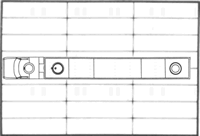
 Moving on the curves is also as normal, however the contact zone of the tractor-trailer increases. When moving the rig, move the tractor forward one space, and then move the trailer one space, keeping the tractor wholly within its space, and the rear end of the trailer within its space. Due to the nature of the curve and the straightness of the long trailer, the trailer will overlap into the line of lanes on the inner of the rig, and these lanes (which will only ever be one lane wide) are considered part of the contact zone of the rig.
Moving on the curves is also as normal, however the contact zone of the tractor-trailer increases. When moving the rig, move the tractor forward one space, and then move the trailer one space, keeping the tractor wholly within its space, and the rear end of the trailer within its space. Due to the nature of the curve and the straightness of the long trailer, the trailer will overlap into the line of lanes on the inner of the rig, and these lanes (which will only ever be one lane wide) are considered part of the contact zone of the rig.
Bikes may dodge these additional contact zones, cars may not.
| Movement on Curve | Curve Contact Zone |
|---|
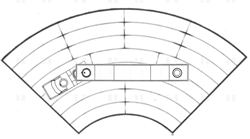 |
 |
Note that on some of the outer lanes on some curves, the rig may actually extend into four spaces, due to the fact that the spaces on the outer lanes are smaller than normal. In these circumstances, extend the contact zone of the rig to four spaces. These spaces may not be dodged by bikes.
 Drifts for rigs are a two-phase movement option. In the first phase, move the tractor one space forward and then one lane either side. Move the trailer one space forward, but not one lane to the side. The rig has a contact zone of 3 lanes wide.
In the second phase, move the tractor forward one space and then move the trailer one space forward and one lane to the side that the tractor moved, bringing the trailer in line with the tractor. The rig has a contact zone of 3 lanes wide.
Drifts for rigs are a two-phase movement option. In the first phase, move the tractor one space forward and then one lane either side. Move the trailer one space forward, but not one lane to the side. The rig has a contact zone of 3 lanes wide.
In the second phase, move the tractor forward one space and then move the trailer one space forward and one lane to the side that the tractor moved, bringing the trailer in line with the tractor. The rig has a contact zone of 3 lanes wide.
| Drift on Straight | Drift Contact Zone |
|---|
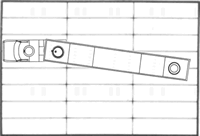 |
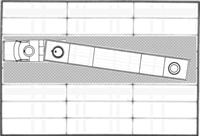 |
| Drift on Curve | Drift Contact Zone |
|---|
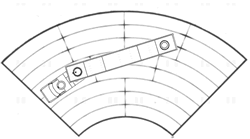 |
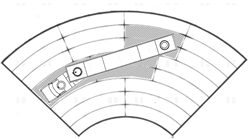 |
The golden rule with curves is that the front and rear ends of the rig are moved as per the rules above, but any spaces that the trailer intersects are all contact zones of the vehicle.
 The following manoeuvres are not permitted by a tractor-trailer combination.
The following manoeuvres are not permitted by a tractor-trailer combination.
 Bootlegger Turns
Bootlegger Turns
 Swerves
Swerves
 U-Turn
U-Turn
The rig is just too big to be able to perform these manoeuvres, and in the case of the U-turn, a road is just too small an area to be able to turn around.
 Tractors may make Control Loss Tests as a normal car. Rigs use the following chart when they lose control.
Tractors may make Control Loss Tests as a normal car. Rigs use the following chart when they lose control.
| Die roll | Control Loss Result |
|---|
| 1 or less | Regain Control |
| 2 |
Trailer Skid and Regain Control:
Move the tractor as normal, but the trailer is moved out one lane in the opposite direction of the tractors manoeuvre. Thus if the tractor was drifting or turning left, then the trailer skids to the right. If the control roll was due to a hazard rather than a manoeuvre, then roll for the trailer direction - even results skid right, while odd results drift left.
Note that the trailer may now have a contact zone of 3 or 4 lanes in width, but the tractors will remain as normal. |
| 3 |
Tractor Skid and Regain Control:
The tractor must make a normal skid test. The trailer is moved as if the tractor had made a normal manoeuvre. |
| 4 |
Trailer Skid and remain Out of Control:
As a normal Trailer Skid above, but the vehicle remains out of control. |
| 5 |
Tractor Skid and remain Out of Control:
As a normal Tractor Skid above, but the vehicle remains out of control. |
| 6,7 |
Severe Skid:
The tractor makes a skid test and the trailer also skids 1d3 lanes as noted above in result 2. A Trailer-Break test must also be made. |
| 8+ |
Rig Rolls:
The tractor and trailer skid as per a severe skid above, and then the rig flips onto its side. The side fallen onto will be the side that the skid was in the direction of. If this cannot be determined, roll a die - evens right, odds left. This will cover a large area of contact. The sides of trailer and tractor that hit the ground take a standard speed factor damage per speed factor of the vehicle. Each turn it then loses 30 mph of speed, but still moves along the road until it is stationary. The vehicle is then considered wrecked. |
 If a skid causes the trailer to leave the road, then conduct all skids as normal, but each movement phase that the trailer is off the road, reduce the speed of the rig by an additional 5 mph.
If a skid causes the trailer to leave the road, then conduct all skids as normal, but each movement phase that the trailer is off the road, reduce the speed of the rig by an additional 5 mph.
If the trailer ever skids more than 2 lanes away from the normal straight line movement position of the rig (to make the contact zone width a minimum of 4 lanes wide), then make a trailer-break test, and continue for every move that this is the case.
 If a rig is put under too much strain, then there's a chance that the connection bolt that keeps the trailer attached to the tractor (the fifth wheel), will break. If this happens, then the trailer will no longer be attached to the tractor.
If a rig is put under too much strain, then there's a chance that the connection bolt that keeps the trailer attached to the tractor (the fifth wheel), will break. If this happens, then the trailer will no longer be attached to the tractor.
If ever a Trailer-Break test has to be made, roll a die. On an Even score, the trailer stays attached to the tractor, but on an odd score, the connection and fifth wheel breaks, and the trailer comes loose. This is a loose trailer situation.

 Trucks and rigs are big and heavy. They are easily able to pulverise almost anything that gets in their way with ease.
Trucks and rigs are big and heavy. They are easily able to pulverise almost anything that gets in their way with ease.
Ram damage is calculated as follows.
Note that if two rigs are ramming each other, then all damage is as per the standard rules. These notes only apply to one vehicle being a rig and the other vehicle something else.
 The tractor takes combined speed factor damage.
If the rig just consists of a tractor, then the opposing vehicle takes damage as if the speed factor was one higher.
If the rig consists of a tractor-trailer, then the opposing vehicle takes damage as if the speed factor of the rig was doubled (with a minimum of +1).
The tractor takes combined speed factor damage.
If the rig just consists of a tractor, then the opposing vehicle takes damage as if the speed factor was one higher.
If the rig consists of a tractor-trailer, then the opposing vehicle takes damage as if the speed factor of the rig was doubled (with a minimum of +1).
In a head-on ram, the non-rigs speed is reduced to zero.
If the rig just consists of a tractor, then its speed is reduced by an amount equalling three-quarters of the opposing vehicles speed.
If the rig consists of a tractor-trailer, then its speed is reduced by an amount equalling half the speed of the opposing vehicle.
The rig should make a hazard roll with a safety limit of 50 mph.
 Other rams are treated as normal, but the non-rig vehicle takes damage as if the rig had a speed factor of one higher than it actually is.
Other rams are treated as normal, but the non-rig vehicle takes damage as if the rig had a speed factor of one higher than it actually is.
If a rig is involved in a shunt then any speed adjustments are halved. A rig is too big and heavy to be able to get much of a speed boost or penalty from a smaller vehicle.
If a rig is involved in a sideswipe, then it loses 5 mph of speed, or 10 mph if it is in opposing directions.
Add 10 mph to all safety limits for the rig when it makes hazard rolls. Again, the heavier weight of the vehicle makes it more stable in rams.
 If a tractor or rig rams a motorcycle, and if their speed is greater than the cycles, they will pretty much run right over the much smaller vehicle. If the collision was a head-on ram for the rig, then it will run right over the cycle. This will total the motorbike completely and kill anyone on board. This is only a minor hazard for the truck - it has a safety limit of 40 mph.
If a tractor or rig rams a motorcycle, and if their speed is greater than the cycles, they will pretty much run right over the much smaller vehicle. If the collision was a head-on ram for the rig, then it will run right over the cycle. This will total the motorbike completely and kill anyone on board. This is only a minor hazard for the truck - it has a safety limit of 40 mph.

